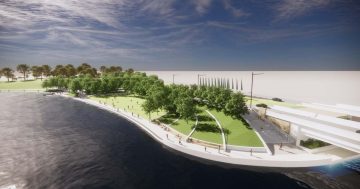
Parkes Way is one of the city’s only east to west arterial roads. Some want it buried. Photo: ACT Government.
An old idea to turn one of Canberra’s major arterial roads into a tunnel has resurfaced again, albeit now with in-principle support from the National Capital Authority (NCA).
ACT senator David Pocock revealed his “vision for Canberra” at the Canberra Region Tourism Advisory Forum on Tuesday 1 August, including plans to send a significant length of Parkes Way “underground”.
“The lake is the stunning centrepiece around which Canberra was designed – it should not be separated from the city by a four-lane dual carriageway,” he said.
The plan would tunnel roughly 3 km along the length of Parkes Way, starting at Edinburgh Avenue, continuing past Anzac Parade and re-emerging before Kings Avenue.
This, Mr Pocock argued, would “help realise the internal logic of Griffin’s original vision for Canberra” while also creating space for “dozens” of mixed-use developments ripe with cafes, restaurants, bars, hotels and residences “sloping down toward the grass-lined lakefront”.
The sale of this land would also “entirely offset” the cost of the project.
Sound idyllic? It has for years.
Convenor of community organisation Greater Canberra, Howard Maclean, has advocated for burying Parkes Way ever since the ACT Government first dumped plans for a new stadium in Civic in September 2022.
“The big problem with Parkes Way and its cloverleaves is that they take up too much space and cut the city off from the lake,” Mr Maclean told Region at the time.
“It means people who are in the city can’t easily use the lake and Commonwealth Park without having to go over one of those narrow pedestrian bridges or hopping in the car.”

An artist’s impression of a new “connected” lakefront. Photo: Hill Thalis / Ross Caddaye / ACT Government.
The NCA, which manages the lake and adjacent lands on behalf of the Federal Government, has now chimed in with its support, despite an initial vague statement about how it’s “committed to creating a national capital of which all Australians can be proud”.
“Free and open public spaces, created in a sustainable way and alive with activity, recreational and sporting festivals, and thoughtful and respectful commemoration, all play a part in securing such a city,” the statement read.
NCA CEO Sally Barnes went on 2CC radio on 4 August to say her planning team had looked over Pocock’s proposal and their “first gut reaction was, ‘This would be great'”.
“Burying Parkes Way is not a new idea, but it’s a bold idea and one that might be too expensive,” she said.
“But if you look at it from a planning perspective, Parkes Way was never in the original Griffin plan. It came about when we all got motor cars … but if you were starting again, putting Parkes Way under and having a more gentle way to reach Commonwealth Park would be fantastic.”
The NCA has yet to conduct any cost estimate on the proposal, but Ms Barnes hinted at the fact it wouldn’t come cheap.
“If it were a perfect world, we had lots of money, and you thought about how you might enhance the area, it would be nice.”
So far, the ACT Government has matched the $2.5 million provided by the Australian Government to investigate future improvements to Parkes Way, between Glenloch Interchange and Kings Avenue.
In 2013, then Chief Minister Katy Gallagher unveiled a ‘City to Lake Vision’ including plans to link the city to the lakefront by sending a portion of Parkes Way underground. At the time, the government was told it would create enough new land to cover the costs, and then some.

A 2013 report estimated the government could make $386 million on land sales by burying Parkes Way. Photo: File.
A report estimated the cost of the project (along with works on Commonwealth Avenue and West Basin) at $210 million, with a 40 per cent contingency. Within five to seven years, approximately $386 million would return to the government’s coffers in block sales.
“This equates to less than 50 per cent of the development potential unlocked by the initial infrastructure investment,” it read.
However, less than a year later in 2014, another report said the project would cost $460 million. Given inflation since then, this estimate would be more like $550 million.
The government now says it is not considering lowering Parkes Way “at this stage”, even if parts of Pocock’s vision do overlap with a plan to “relieve traffic congestion, increase freight productivity and improve safety”.





















